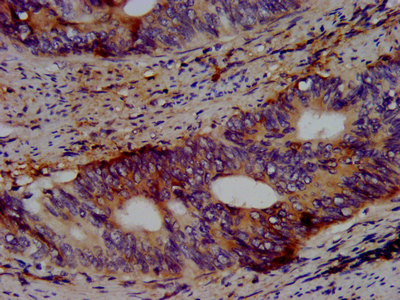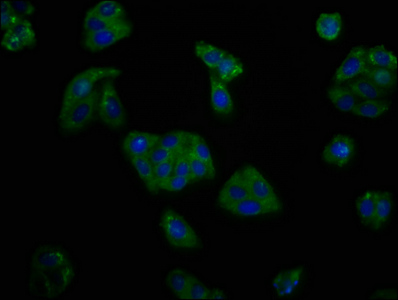KCNV2 Antibody
-
中文名稱:KCNV2兔多克隆抗體
-
貨號:CSB-PA848410LA01HU
-
規格:¥440
-
圖片:
-
IHC image of CSB-PA848410LA01HU diluted at 1:500 and staining in paraffin-embedded human colon cancer performed on a Leica BondTM system. After dewaxing and hydration, antigen retrieval was mediated by high pressure in a citrate buffer (pH 6.0). Section was blocked with 10% normal goat serum 30min at RT. Then primary antibody (1% BSA) was incubated at 4°C overnight. The primary is detected by a biotinylated secondary antibody and visualized using an HRP conjugated SP system.
-
Immunofluorescence staining of HepG2 cells with CSB-PA848410LA01HU at 1:166, counter-stained with DAPI. The cells were fixed in 4% formaldehyde, permeabilized using 0.2% Triton X-100 and blocked in 10% normal Goat Serum. The cells were then incubated with the antibody overnight at 4°C. The secondary antibody was Alexa Fluor 488-congugated AffiniPure Goat Anti-Rabbit IgG(H+L).
-
-
其他:
產品詳情
-
產品名稱:Rabbit anti-Homo sapiens (Human) KCNV2 Polyclonal antibody
-
Uniprot No.:
-
基因名:KCNV2
-
別名:KCNV2; Potassium voltage-gated channel subfamily V member 2; Voltage-gated potassium channel subunit Kv8.2
-
宿主:Rabbit
-
反應種屬:Human
-
免疫原:Recombinant Human Potassium voltage-gated channel subfamily V member 2 protein (1-155AA)
-
免疫原種屬:Homo sapiens (Human)
-
標記方式:Non-conjugated
本頁面中的產品,KCNV2 Antibody (CSB-PA848410LA01HU),的標記方式是Non-conjugated。對于KCNV2 Antibody,我們還提供其他標記。見下表:
-
克隆類型:Polyclonal
-
抗體亞型:IgG
-
純化方式:>95%, Protein G purified
-
濃度:It differs from different batches. Please contact us to confirm it.
-
保存緩沖液:Preservative: 0.03% Proclin 300
Constituents: 50% Glycerol, 0.01M PBS, pH 7.4 -
產品提供形式:Liquid
-
應用范圍:ELISA, IHC, IF
-
推薦稀釋比:
Application Recommended Dilution IHC 1:500-1:1000 IF 1:50-1:200 -
Protocols:
-
儲存條件:Upon receipt, store at -20°C or -80°C. Avoid repeated freeze.
-
貨期:Basically, we can dispatch the products out in 1-3 working days after receiving your orders. Delivery time maybe differs from different purchasing way or location, please kindly consult your local distributors for specific delivery time.
-
用途:For Research Use Only. Not for use in diagnostic or therapeutic procedures.
相關產品
靶點詳情
-
功能:Potassium channel subunit. Modulates channel activity by shifting the threshold and the half-maximal activation to more negative values.
-
基因功能參考文獻:
- Pharmacogenetic and case-control study evaluated the role of the variants of KCNA1, KCNA2, and KCNV2 in the susceptibility and drug resistance of genetic generalized epilepsies and revealed no significant association between 8 variants of KCNA1, KCNA2, and KCNV2 genes and risk or drug resistance of genetic generalized epilepsies after a Bonferroni correction for multiple comparisons. PMID: 28658141
- The 2 mutations identified are novel and thus expand the current knowledge of Retinal Cone Dystrophy 3B genotype-phenotype descriptions in the literature. PMID: 24029832
- This is the first report of genetic and clinical analysis of cone dystrophy with supernormal rod response in the Israeli population leading to the identification of 4 novel KCNV2 mutations. PMID: 23725738
- Compound heterozygosity for the two alleles of KCNV2, p.C177R and p.G461R, in three patients, and homozygosity for complex alleles, p.R27H and p.R206P, in one patient from the consanguineous family, is reported. PMID: 23885164
- Central vision parameters progressively worsen in KCNV2 cone dystrophy, structural retinal and lipofuscin accumulation abnormalities are commonly present and macular cone photoreceptor mosaic is markedly disrupted early in the disease. PMID: 23221069
- KCNV2 mutations cause a unique form of retinal disorder illustrating the importance of K(+)-channels for the resting potential, activation and deactivation of photoreceptors, while phototransduction remains unchanged PMID: 23077521
- important finding leading to identification of KCNV2 as a candidate gene for causative mutations was the characteristic pattern of findings on full field ERGs. PMID: 23143909
- two pore mutations (W467G and G478R) led to the formation of nonconducting heteromeric Kv2.1/Kv8.2 channels PMID: 23115240
- For all patients, KCNV2 sequencing revealed one of three homozygous recessive mutations PMID: 21900228
- In this study, we found that KCNV2 mutations are present in a substantial fraction (2.2-4.3%) of a sample of 367 independent patients with a variety of initial clinical diagnoses of cone malfunctino. PMID: 21882291
- In KCNV2 retinopathy foveal morphological changes are evident on SD-OCT even in the early stages of disease. PMID: 21558291
- Early ocular phenotype in siblings with a homozygous p.G461R mutation in the KCNV2 gene presented nystagmus, increased light sensitivity, reduced color discrimination, and relative central scotomas. PMID: 21911584
- Results demonstrate that altered potassium subunit function influences epilepsy susceptibility and implicate Kcnv2 as an epilepsy gene. PMID: 21402906
- Individuals with mutations in KCNV2 manifest a wide range of macular and autofluorescence abnormalities. PMID: 19952985
- Mutations mapped to KCNV2 are responsible for cone dystrophy with supernormal rod electoretinogram. PMID: 16909397
- KCNV2 mutations account for most if not all cases of cone dystrophy with a supernormal rod electroretinography. We found 1 frameshift, 2 nonsense, 1 non-stop, and 6 missense mutations. PMID: 17896311
- The phenotype of cone dystrophy with supernormal rod response is tightly linked with mutations in KCNV2. PMID: 18235024
- The three novel truncative mutations are likely to be null mutations leading to loss of function, with no difference in the phenotype presentation. PMID: 18400204
- Kv11.1 (ERG1) K+ channels localize in cholesterol and sphingolipid enriched membranes and are modulated by membrane cholesterol. PMID: 18708743
顯示更多
收起更多
-
相關疾病:Cone dystrophy retinal 3B (RCD3B)
-
亞細胞定位:Cell membrane; Multi-pass membrane protein. Note=Has to be associated with KCNB1 or possibly another partner to get inserted in the plasma membrane. Remains intracellular in the absence of KCNB1.
-
蛋白家族:Potassium channel family, V (TC 1.A.1.2) subfamily, Kv8.2/KCNV2 sub-subfamily
-
組織特異性:Detected in lung, liver, kidney, pancreas, spleen, thymus, prostate, testis, ovary and colon.
-
數據庫鏈接:
Most popular with customers
-
-
YWHAB Recombinant Monoclonal Antibody
Applications: ELISA, WB, IHC, IF, FC
Species Reactivity: Human, Mouse, Rat
-
Phospho-YAP1 (S127) Recombinant Monoclonal Antibody
Applications: ELISA, WB, IHC
Species Reactivity: Human
-
-
-
-
-





















